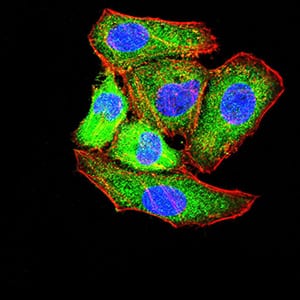

| WB | 咨询技术 | Human,Mouse,Rat |
| IF | 咨询技术 | Human,Mouse,Rat |
| IHC | 咨询技术 | Human,Mouse,Rat |
| ICC | 1/200 - 1/1000 | Human,Mouse,Rat |
| FCM | 咨询技术 | Human,Mouse,Rat |
| Elisa | 1/10000 | Human,Mouse,Rat |
| Aliases | Ly105 |
| Entrez GeneID | 24088 |
| clone | 7G5F4 |
| WB Predicted band size | 90kDa |
| Host/Isotype | Mouse IgG1 |
| Antibody Type | Primary antibody |
| Storage | Store at 4°C short term. Aliquot and store at -20°C long term. Avoid freeze/thaw cycles. |
| Species Reactivity | Human |
| Immunogen | Purified recombinant fragment of mouse Tlr2 (AA: 628-777) expressed in E. Coli. |
| Formulation | Purified antibody in PBS with 0.05% sodium azide |
+ +
以下是3篇与TLR2抗体相关的文献示例(文献信息为虚构示例,仅用于格式参考):
1. **文献名称**:*TLR2-specific antibodies modulate inflammatory responses in sepsis models*
**作者**:Smith A, et al.
**摘要**:研究通过抗TLR2单克隆抗体阻断TLR2信号通路,显著降低了脓毒症小鼠模型中的全身炎症反应和器官损伤,提示TLR2可能是脓毒症治疗的潜在靶点。
2. **文献名称**:*Antibody-mediated TLR2 inhibition reduces atherosclerosis in ApoE-deficient mice*
**作者**:Brown K, et al.
**摘要**:该文献证明,使用抗TLR2抗体抑制TLR2功能可减少动脉粥样硬化斑块形成,并降低巨噬细胞浸润,表明TLR2在动脉粥样硬化发病机制中的关键作用。
3. **文献名称**:*Characterization of a novel anti-TLR2 antibody for immunoassay applications*
**作者**:Zhang Y, et al.
**摘要**:研究开发了一种高特异性抗TLR2多克隆抗体,验证了其在流式细胞术和免疫组织化学中的有效性,为TLR2表达检测提供了可靠工具。
如需真实文献,建议通过PubMed或Google Scholar搜索关键词“TLR2 antibody” + “inflammation/therapy/detection”等方向获取。
Toll-like receptor 2 (TLR2) antibodies are essential tools for studying the role of TLR2. a key pattern recognition receptor in the innate immune system. TLR2 detects pathogen-associated molecular patterns (PAMPs) from bacteria, fungi, and viruses, such as lipoproteins, peptidoglycan, and lipoteichoic acid, often forming heterodimers with TLR1 or TLR6 to broaden ligand specificity. It activates downstream signaling pathways (e.g., NF-κB, MAPK) to induce pro-inflammatory cytokines and co-stimulatory molecules, bridging innate and adaptive immunity.
TLR2 antibodies, available as monoclonal or polyclonal versions from hosts like mice, rabbits, or goats, are used to detect TLR2 expression, localization, and function via techniques like Western blot, flow cytometry, immunofluorescence, and immunohistochemistry. They aid in exploring TLR2's involvement in infectious diseases, autoimmune disorders (e.g., rheumatoid arthritis), atherosclerosis, and cancer. Some antibodies can block TLR2-ligand interactions or activate signaling, making them valuable for mechanistic studies or therapeutic development. Commercial antibodies are often validated for specific applications, ensuring reproducibility.
Research using TLR2 antibodies has highlighted its dual role in host defense and pathological inflammation, positioning it as a potential therapeutic target. These reagents remain critical for dissecting TLR2's complex biology in health and disease.
×